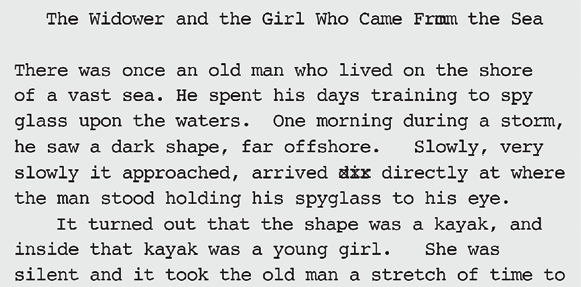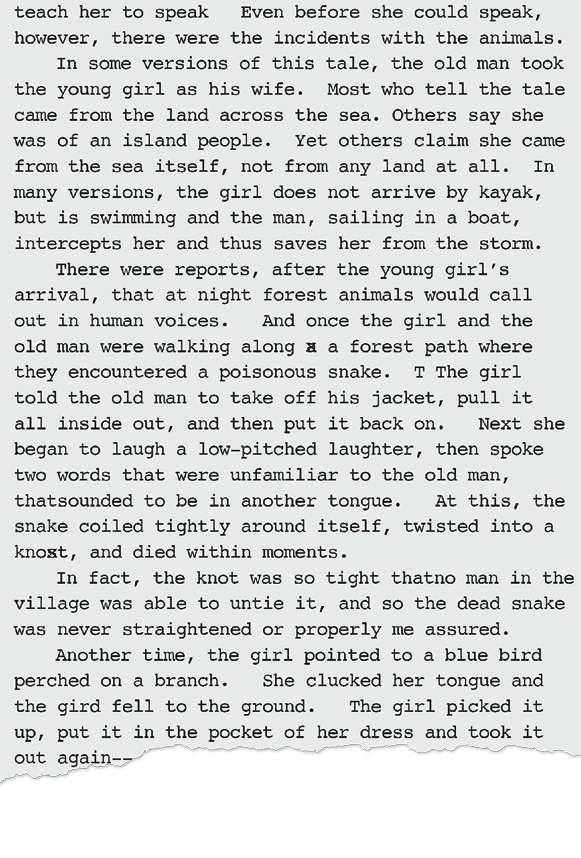No one had heard from or about Mrs. Abel, when or whether she planned to return. As the weeks stretched on into July, my hope for her return lapsed, and I reverted to my old ways. I drank beer at the AC Tap, ate innumerable bratwurst, and didn’t swim much at all. I’d been granted a writing fellowship, in California, where I would move in September—that fact relieved any sense of responsibility or anxiety regarding what I should be doing.
A suspicion festered in me, however; I kept thinking about how Mrs. Abel had offered Mr. Zahn’s house to me, how eager she’d seemed that I stay there.
I began to watch Mr. Zahn’s house. I’d sneak up the cow path, climb into the old wooden fishing boat in the trees, the Anne Marie. From there I could see across the yard and into the lighted windows; I could see the dark shape of a young man as he moved from room to room, the blue flicker of his television inside that space.
He’d taken my place, stayed in the house all through the winter and was still living there. His name was Doug Plouff. I wondered about him, how well he knew Mrs. Abel, or if he’d merely answered an advertisement.
Years before, Doug and I had worked together, as dishwashers at the Carroll House Restaurant, but we’d not stayed in touch; he was a local, not a summer person. In the years since I’d known him, he’d lost one hand in a motorcycle accident, but was still washing dishes—at the Edgewater, that summer of 1995, where my younger sister was working as a waitress.
From inside the fishing boat, squinting across the yard, I could also see that the rooms were mostly empty, that all of Mr. Zahn’s animals had been removed. Mrs. Abel had had them all moved, had hired people to carefully wrap everything, to put it all in storage. Back then, that made no sense to me, or anyone, but if you research Robert Zahn now you’ll find him referred to as “The Birdman of Door County,” and learn that his work is collected by experts, and in the collections of the Guggenheim, the American Folk Art Museum, and the Museum of Modern Art. I recently purchased a book about him; the preface says: “Folk artist? Outsider? Visionary? Vernacular artist? The labels point to a unique genre of art—art made by natively talented, untrained artists whose work contains a unique vision.”
When I think of Mr. Zahn, what I remember is his open eyes, the knife in one hand and the half-carved bird in the other, the wood shavings on the floor and Mrs. Abel and myself, both alive, in that screen porch with him.
And now my daughter slides the door open, peers into this room.
“Daddy,” she says, “if you die while you’re having a dream, do you get to keep the dream?”
“Yes,” I say.
I suppose that I could have befriended Doug Plouff again, managed to get into Mr. Zahn’s house that way, yet that seemed more deceitful somehow, and I did not want to be inside if he was going to be there, watching me, asking questions.
One night I watched Doug—a weekend night, when I suspected he’d go out drinking (my sister had recounted some of the misadventures he’d told her about, out all night with a friend named Fat Pat). I waited until he came out of the house, climbed into his car (an old brown Pinto that had actually belonged to my family, once, that my father had sold him for two hundred dollars, that had no floorboards on the passenger side, so you’d be splashed by any puddle) and drove away.
I stole across the overgrown yard, lifted out a screen, and climbed in an open window.
Inside, there was a mattress on the floor covered in tangled sleeping bags. Two beach towels—one Packers, one Leinenkugel beer—were attached to one wall, like banners. A bean bag chair and a canvas camping chair faced two television screens—one large, one very small, both balanced on blue plastic milk cartons.
In the kitchen, beer cans, pizza boxes, a sink full of dirty dishes. I pulled out the drawers, and they were mostly empty. Plastic forks, tangles of rubber bands, fishing hooks. Nothing there—I spun around, searching, my eyes everywhere—felt how I remembered it; it didn’t seem at all like the place where those wooden animals had been, crowded together, where the old man had lived.
I crossed out through the doorway to the screen porch and switched on the light: a metal folding chair, a cardboard box with an overflowing glass ashtray atop it, next to an orange bong covered in Kawasaki and Harley–Davidson stickers. I switched off the light and stood there, listening to the wind in the trees, looking out through the screens at the shadows in the branches, the darker blackness where the cow path descended along the cliff. This is where we’d been, a year before, and now I was the only one left.
Back in the main room, I dragged the bean bag chair to one side. I lifted one end of the mattress, as if that would help me. The lights were on; anyone outside could see me, whatever I was doing. Looking behind everything, under everything, lifting piles of paper and setting them down again.
It was then that I saw the lions. Up high, on the ends of the wooden beams that ran across the ceiling: two carved wooden lion heads, just the same as those on the table Mrs. Abel had taken. Quickly, I lifted the rickety canvas chair and set it under the ceiling beams. I climbed up, balancing, teetering, to see if the lions would somehow open.
At first, nothing, then I squeezed harder on the sides of the lion’s jaws and it came off in my hand, revealing a space, a compartment, there. When I squinted, I could see a small handprint, pressed into the plaster. That was all.
I replaced the lion’s head, leapt down, dragged the chair to the other side, almost tipped over as I reached upward. This one seemed stuck; at first it wouldn’t move, but then all at once it did, and something flashed white, out at me—a bird? I flinched, closed my yes; when I opened them, it took a moment to find it, to see the yellowed paper, curled in a roll.
I leapt down, picked it up from the floor, opened it just enough to see writing, print from a typewriter. I didn’t read it, not right there, but I somehow knew that this was it, what I’d been seeking. Carefully, I set the paper on the sill, then climbed back out the window, as if the house had no doors. I turned to close the window, and the paper was gone; I leaned my head back through the window—nothing on the floor—then stepped back. There, rolled out onto the ice, settled alongside the house. Tenderly, I snatched up the paper, rushed across the yard, back to the safety of the Anne Marie. Inside, holding the paper up in the moonlight, I began to read:


The bottom edge of the paper was torn away, right in the middle of that sentence.